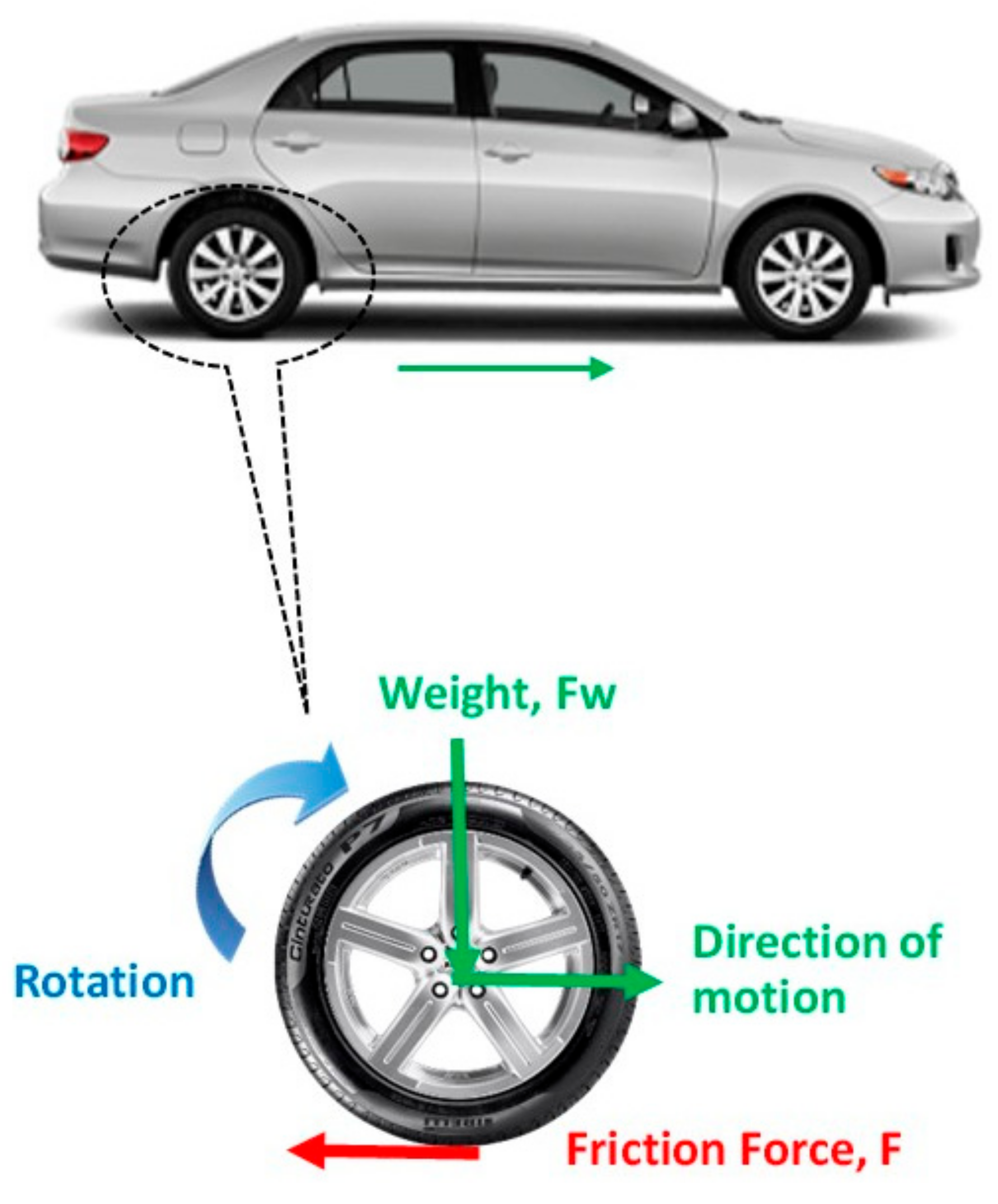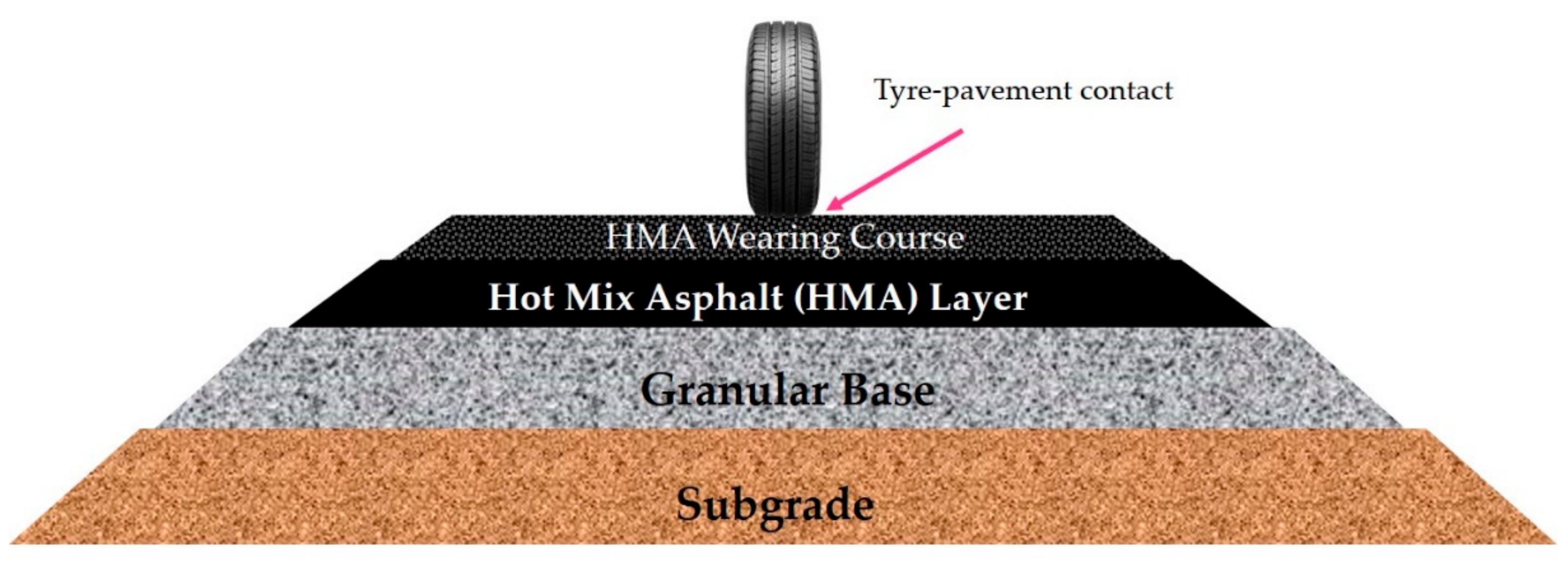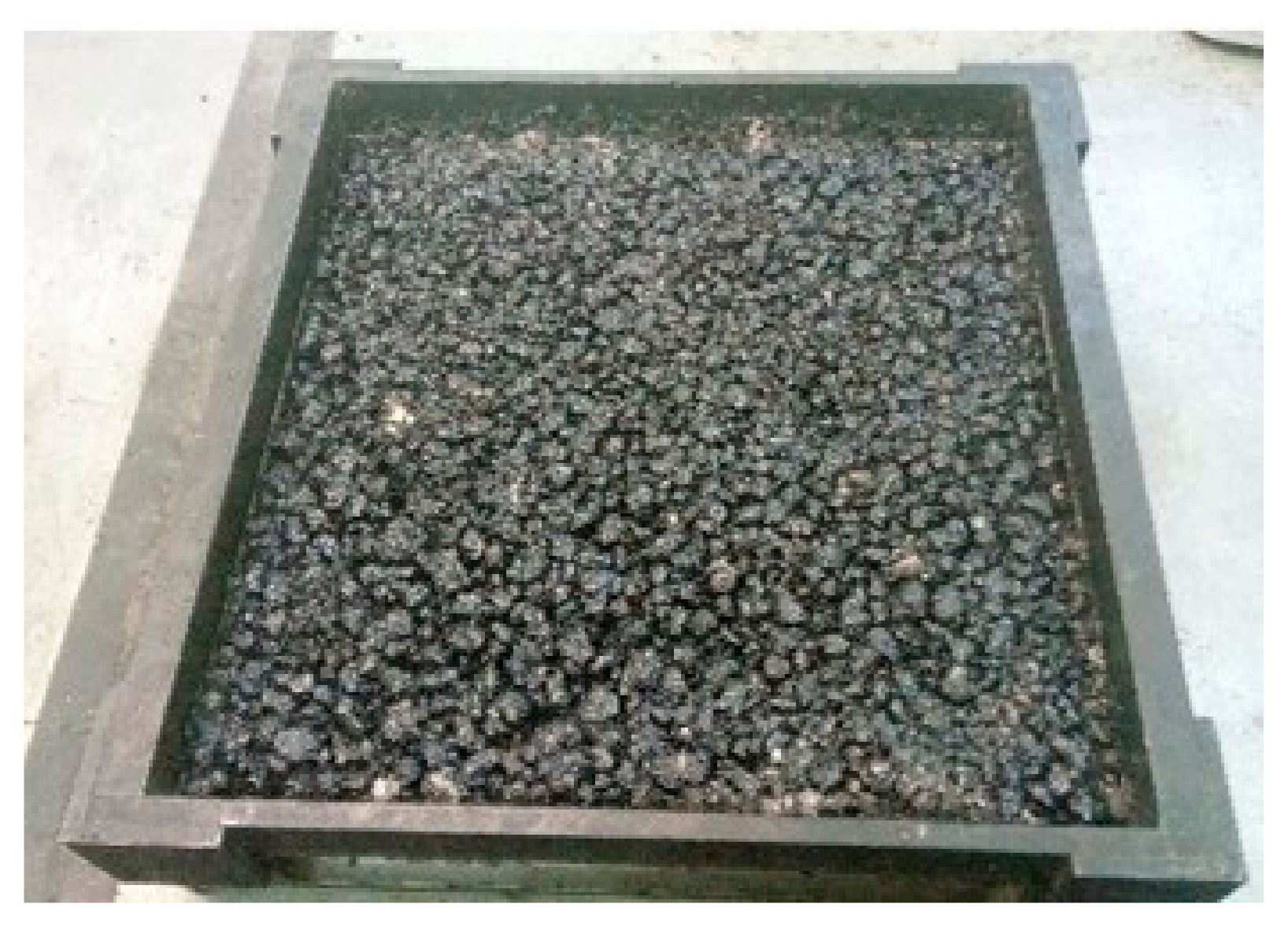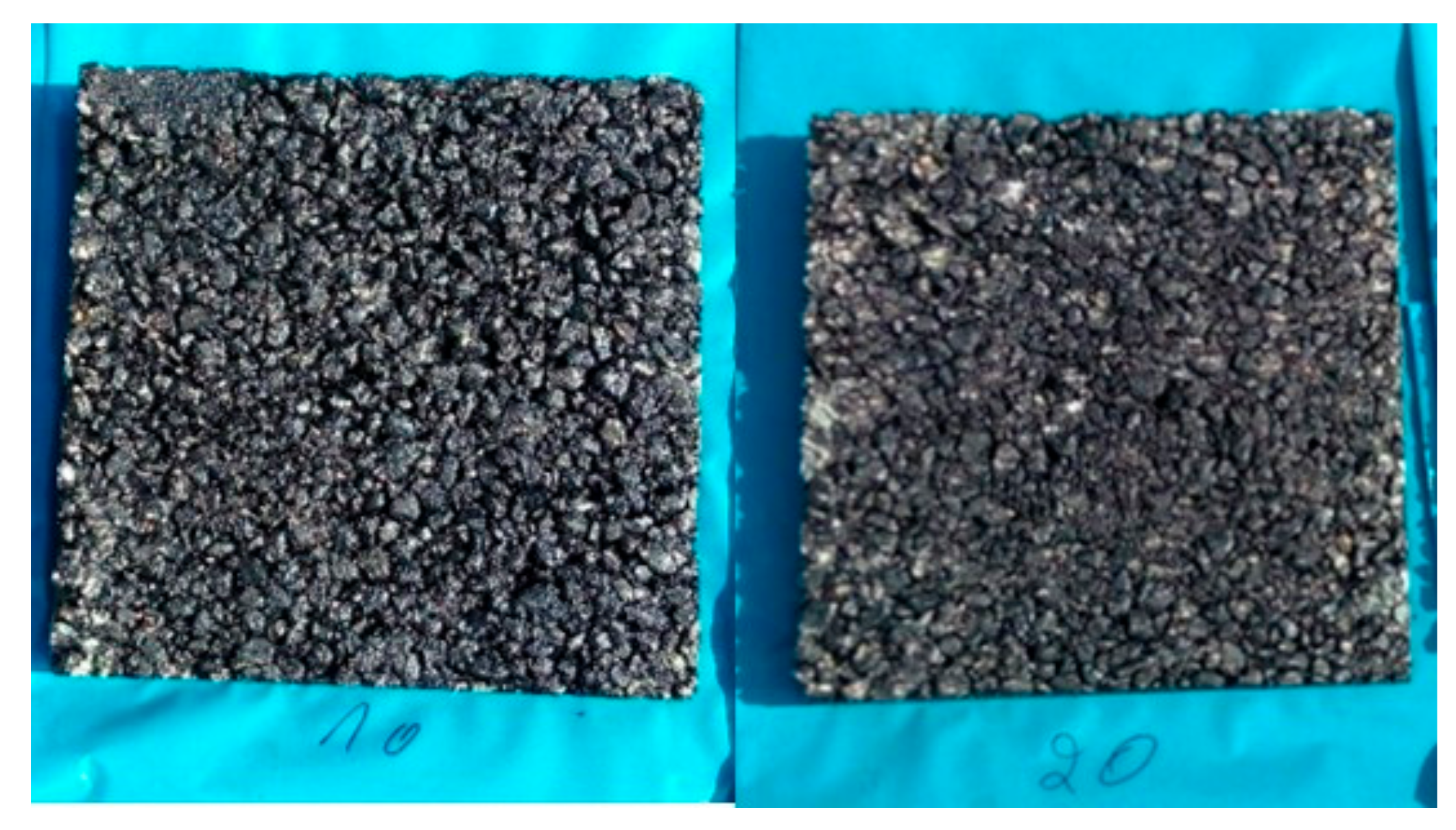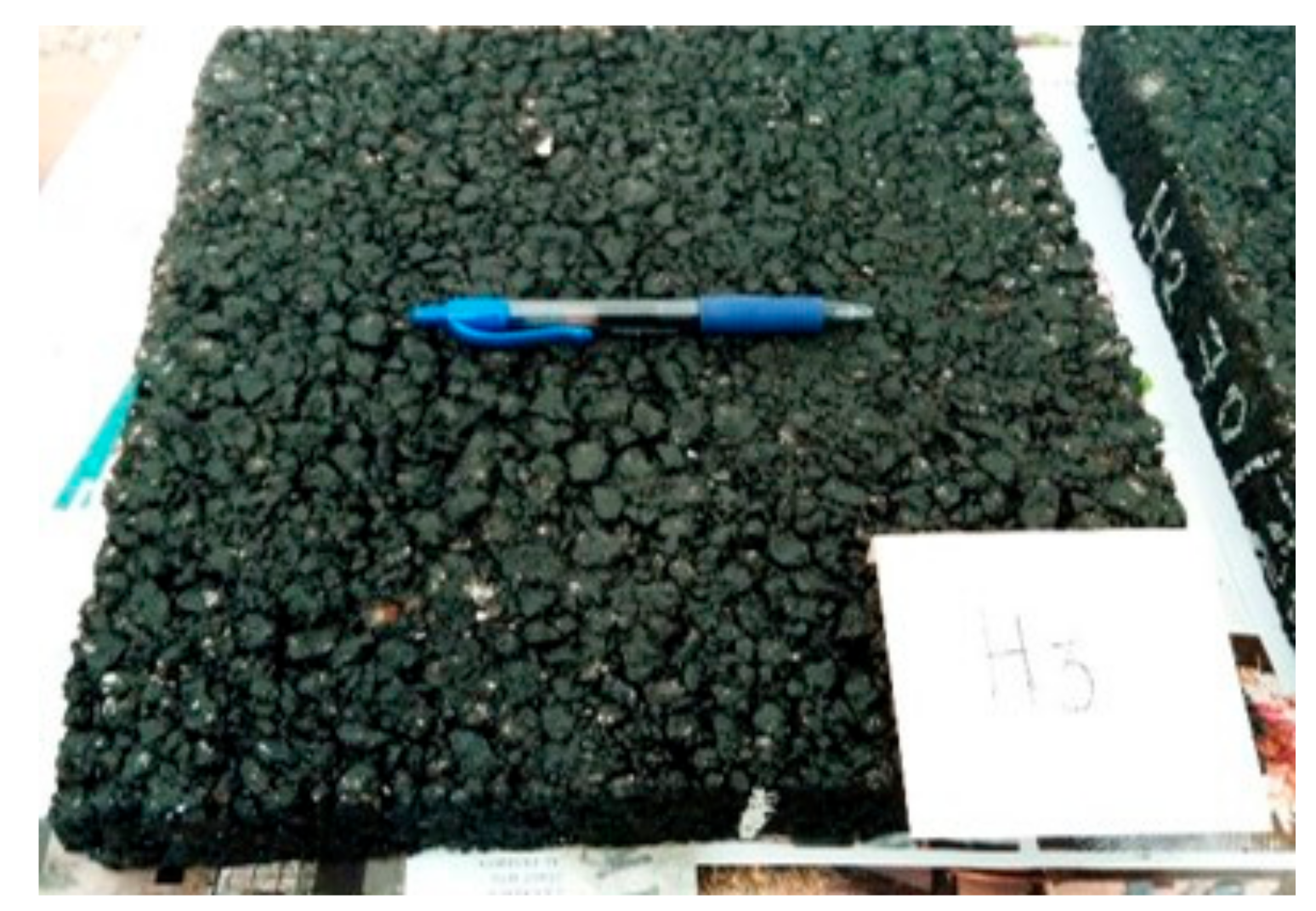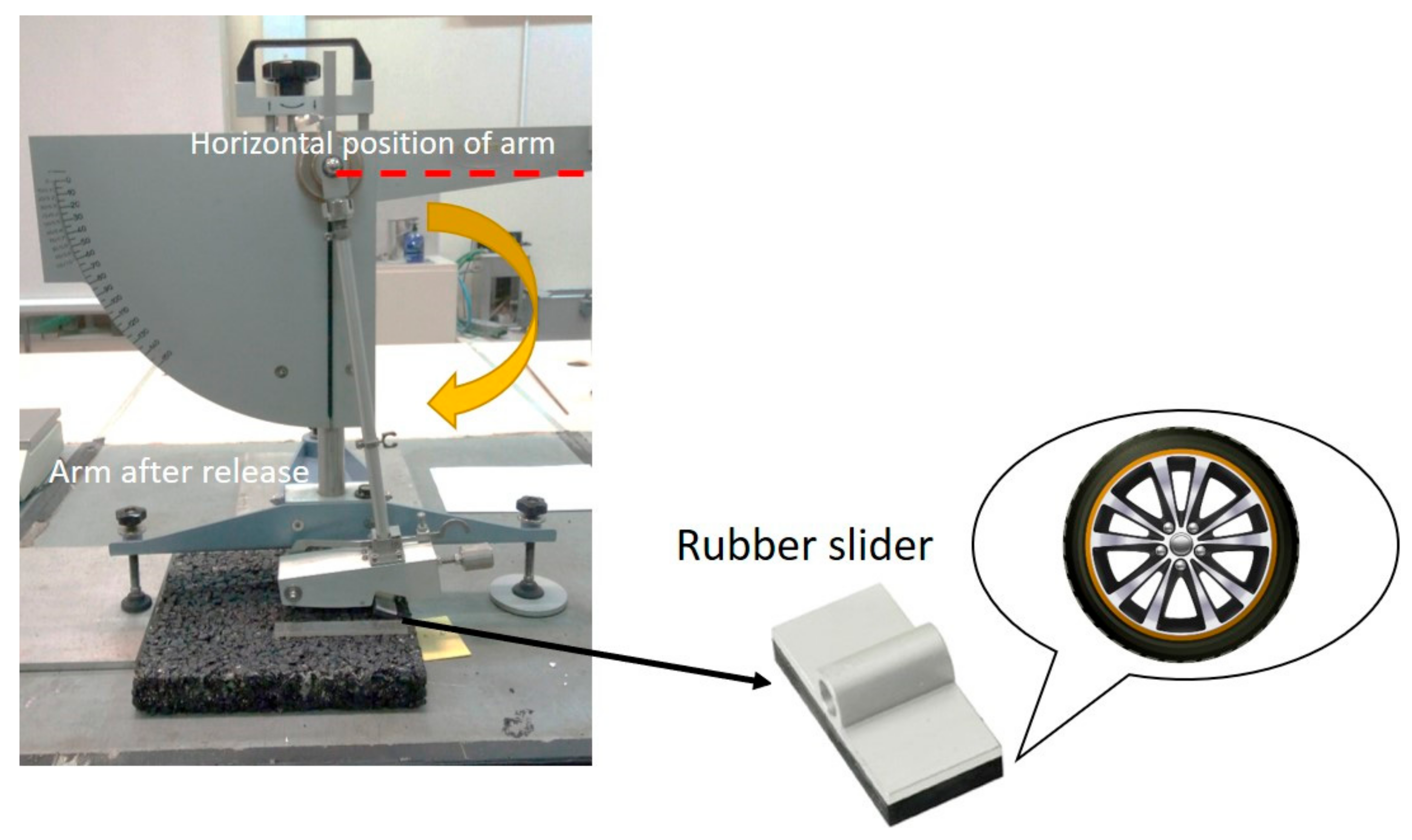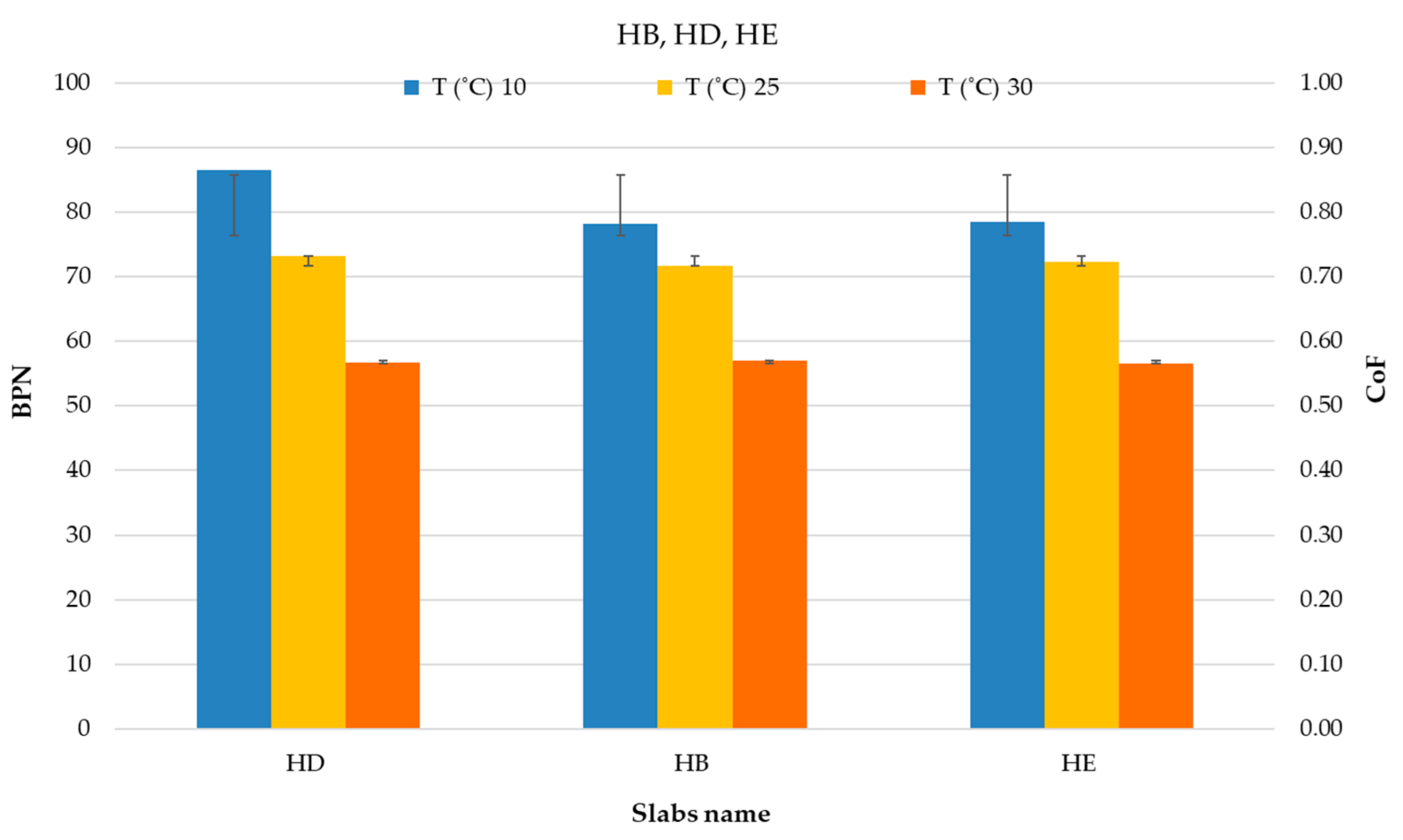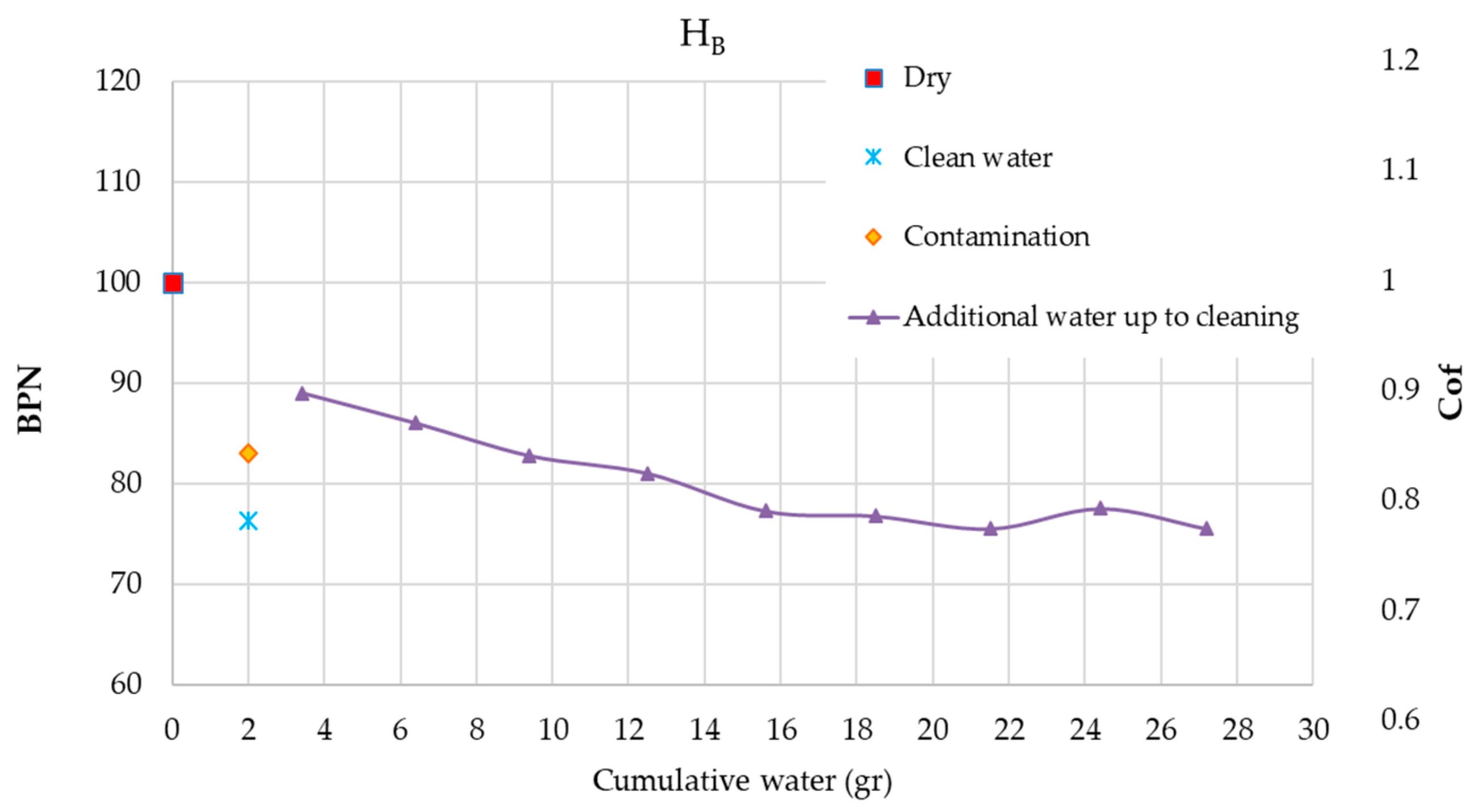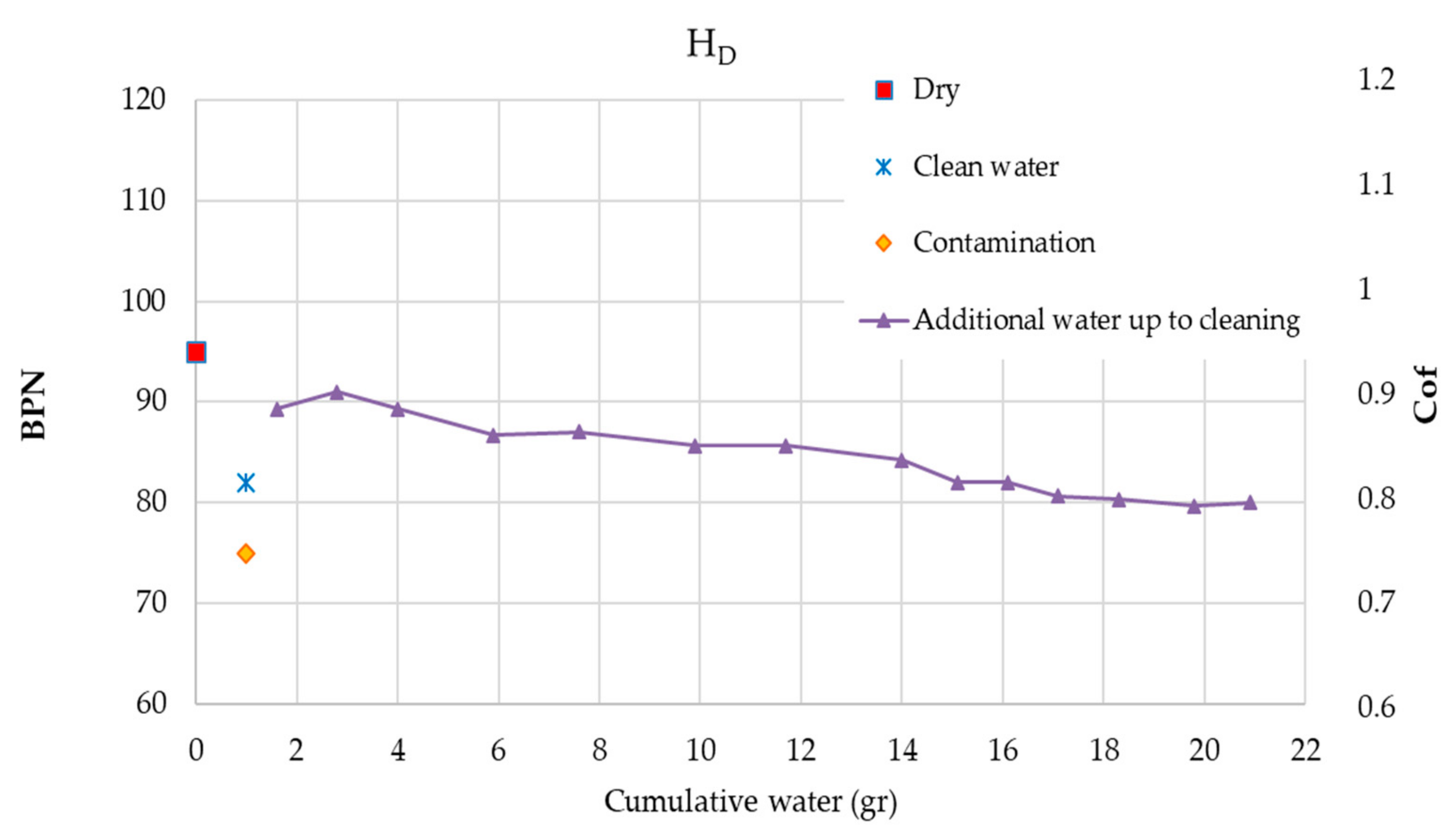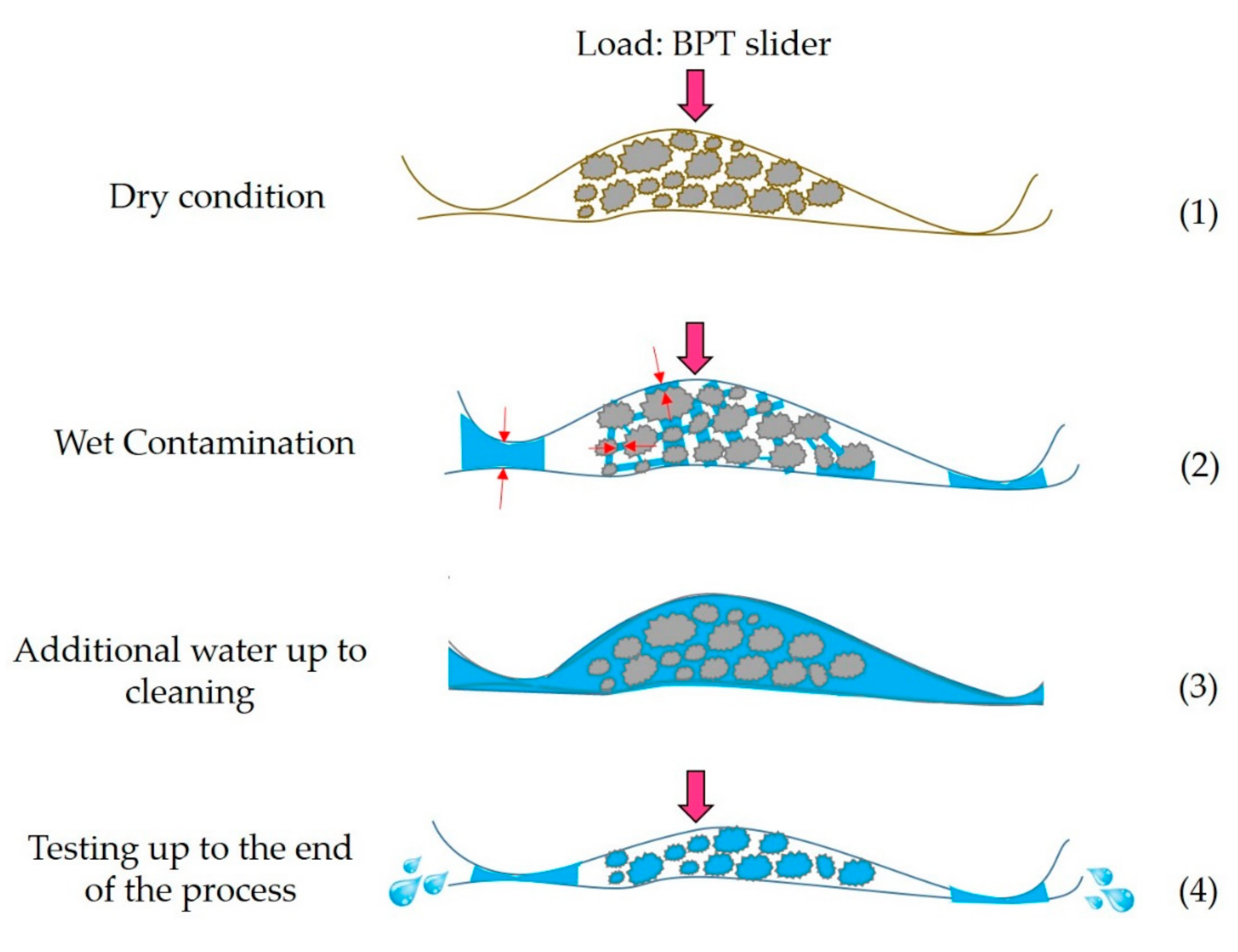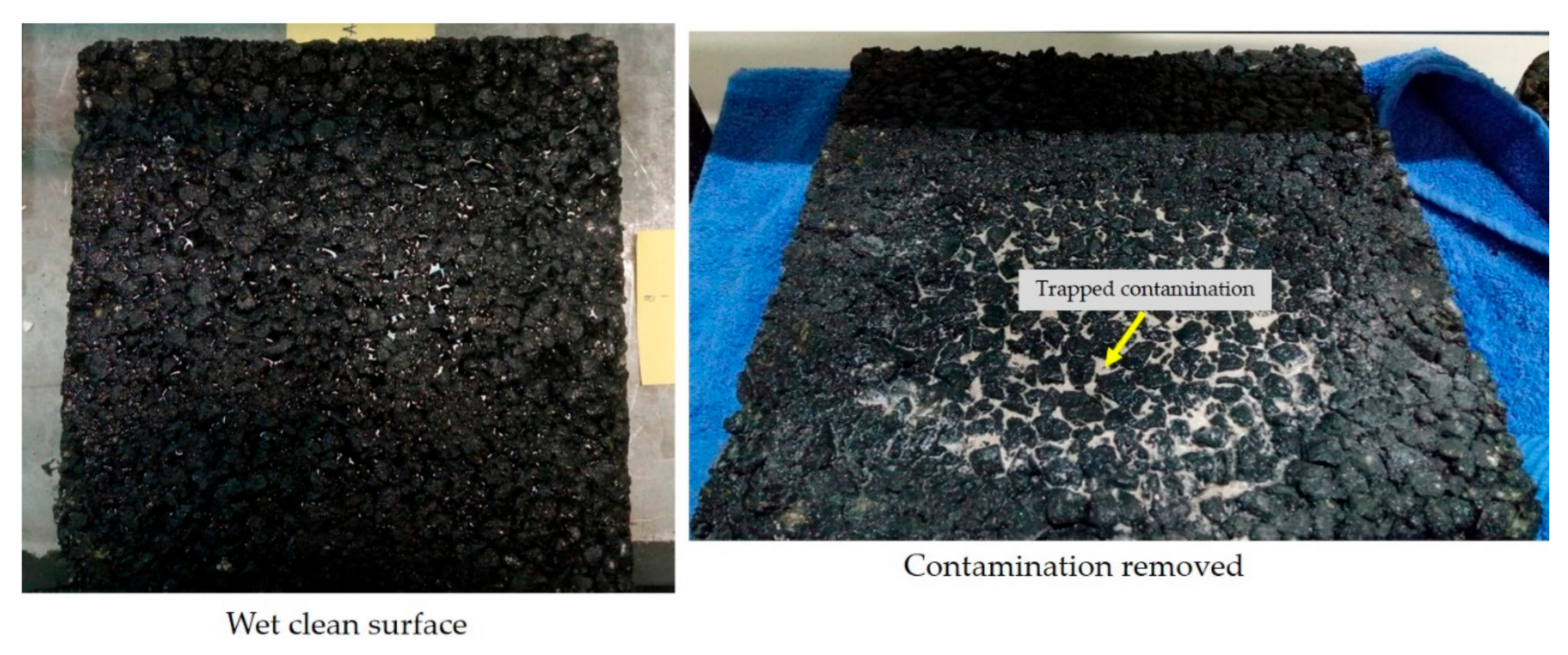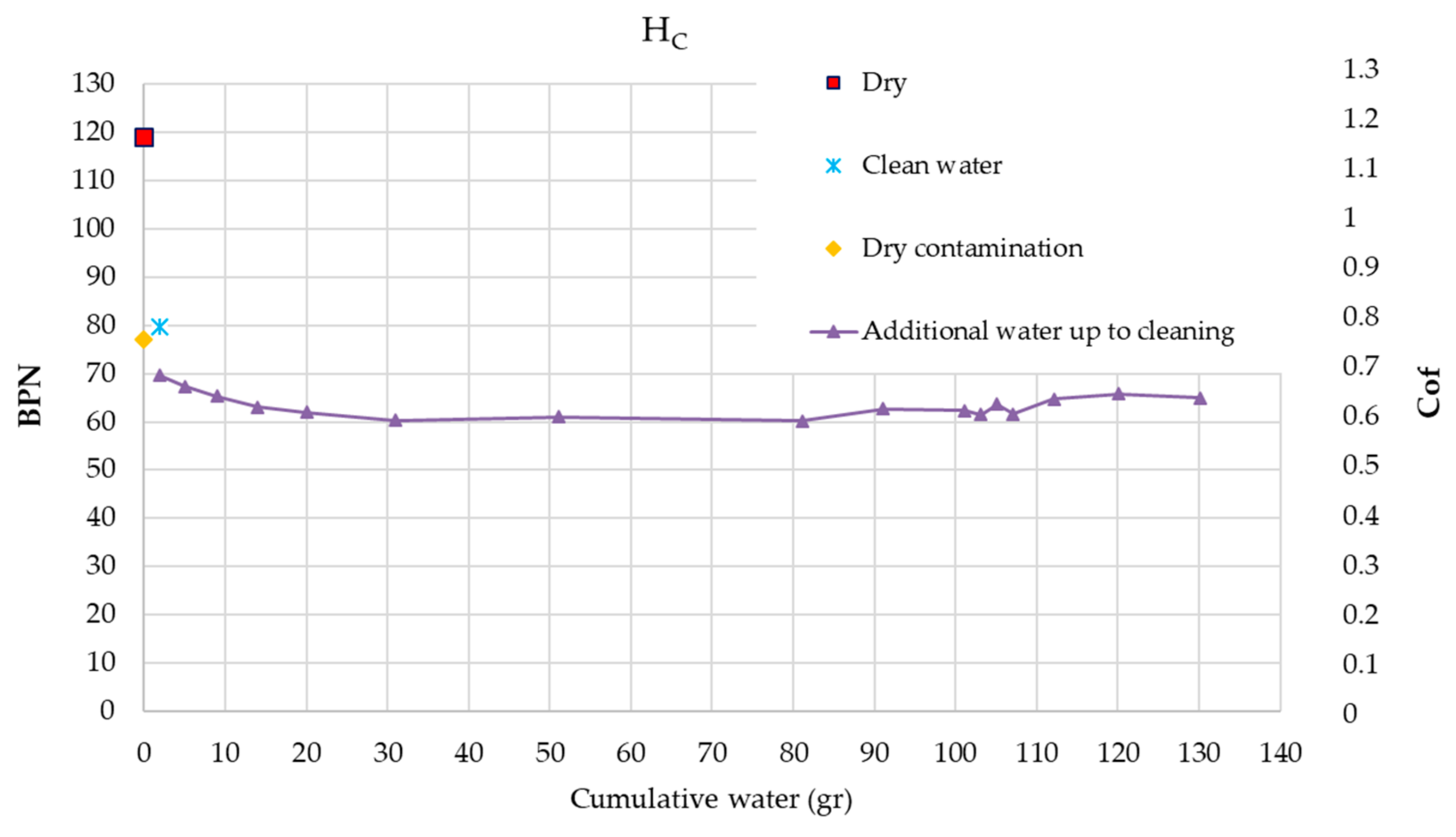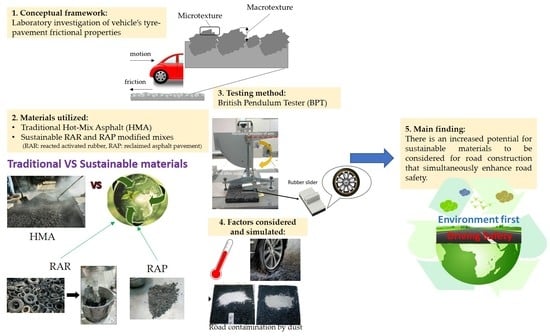1. Introduction
During vehicles movement and braking, resistance forces generate between tyres and road surface, which are considered as a key factor regarding safe driving [
1]. This happens mainly due to the existence of tyre–pavement friction, which is one of the most determinant resistant forces for vehicles’ braking. This justifies why tyre–pavement friction is also connected to vehicles skidding. Each year, numerous fatal incidents occur in a worldwide scale producing evidence in support of the statement that tyre–pavement friction is a crucial component that should ensure sufficient road safety. For instance, in the United States fatal road incidents are one of the leading causes of death, as over a million people dye and around fifty million are injured because of road skidding crashes, making this issue one of the most pressing emergencies nowadays [
2,
3]. For this reason, in many nations road friction is interrelated to road safety and considered as a priority for transportation infrastructure policies [
2]. It has been proved that increases in road friction between vehicles’ tyres and pavement surfaces is critical for reducing skidding related crashes [
3]. Vehicles’ braking performance though, is a bridged result of both industry and infrastructure requirements in terms of tyre characteristics and frictional properties of pavement materials respectively.
In terms of industry requirements, European regulations recently introduced mandatory classification for tyre friction performance by means of tyre labelling in order to ensure increased tyre frictional performance [
4]. The European Union (EU) Commission proposed the new improved regulation on tyre labelling on May 2018 as part of the clean mobility package. The upcoming rules will make the tyre labels more visible and accurate. The new more modern design will be aligned with that of the well-known EU energy label. Informatively, this new regulation will start to apply on May 2021 [
5].
In terms of infrastructure and road materials engineering, the pavement engineering community has faced emerging challenges in respect to the incorporation of sustainable materials into pavement construction during the last decades. This implies that pavement engineers should be alerted and embody materials engineering in order to contribute towards safer roads in conjunction with the vehicle industry requests since road safety during vehicles’ braking is imperative in modern societies. Towards this, the use of reclaimed asphalt pavement (RAP) has been extensively used in many nations with a view to limiting the need for virgin aggregates [
6,
7]. Besides, in order to limit the use of asphalt bitumen bio-materials in form additives in asphalt mixtures such as the reacted activated rubber (RAR) in form of crumbs have been tested [
8,
9]. However, the majority of studies related to the use of sustainable materials focus mainly on bearing capacity issues of roads including among others the use of reclaimed asphalt pavement (RAP) or bio-materials in form additives in asphalt mixtures [
6,
8,
10]. Besides the need for structurally sound roads, there is a scientific gap regarding the characteristics of the sustainable materials from a frictional perspective. In addition, taking into consideration that pavements frictional performance does not remain constant, as it depends on a wide range of environmental factors related to climatic or seasonal changes (e.g., temperature, rainfall, contamination), an issue arises towards exploring materials behavior against these conditions [
11,
12].
To that extent, the objective of the present research is the comparative investigation of frictional performance for traditional and sustainable asphalt mixtures considering the most crucial environmental factors that affect friction levels of pavement surfaces and consequently vehicles’ braking. In particular, seasonal changes are considered through temperature changes, rainfalls effect and contamination. The overall investigation is performed in a laboratory-scale experiment. Traditional and sustainable types of asphalt pavement surfaces were constructed in the laboratory using RAP from an old pavement’s reconstruction project as well as crumb rubber from waste tyres. The ultimate goal of the study is first to quantify the sensitivity of tyre–pavement friction in temperature changes among the traditional and sustainable mixtures; and second to illustrate the frictional fluctuations due to the presence of water on the pavement surface and contamination in the form of loose debris.
In respect to the manuscript organization in the following sections, a thorough background on surface pavement friction is presented first, followed by the description of the laboratory experiment its main results and concluding remarks.
2. Pavement Frictional Performance
Focusing on the vehicles’ braking as a result of a vehicle-infrastructure interaction, friction between the tyre tread and pavement surface is the resistive force developed when a vehicle starts braking, prevented from rotating and instead skids along the pavement surface [
13,
14]. The frictional force between tyres and pavement is generally characterized by a dimensionless coefficient known as coefficient of friction (
CoF), which is the ratio of the tangential force at the contact interface to the longitudinal force on the wheel as shown in
Figure 1 and it is given by Equation (1) [
15].
When a tyre is free rolling along a straight distance, the tyre-contact patch is instantaneously stationary and there is almost no friction at the tyre-road interface [
11]. However, when a driver starts maneuvering including changing speed or direction, friction is developed at the interface as a response to acceleration, braking, or steering and a reaction is caused between the tyre and the pavement wearing courses according to a typical asphalt pavement cross-section illustrated in
Figure 2. The wearing course comes in direct contact with the tyres; thus, it should be characterized by increased friction levels. the afore-mentioned reaction enables the vehicle to speed up and slow down, or even move around curvatures [
3].
From an infrastructure perspective, pavement surface texture is known to directly influence tyre–pavement friction. The two basic components that are critical to the friction development are: macrotexture and microtexture, which are both interrelated to the properties of the materials used for pavement surface construction [
12,
16]. For instance, for a pavement surface made of asphalt mixture, the aggregate gradation in the asphalt—mixture, air void content and binder properties mainly influence the pavement macrotexture, while aggregate mineralogy and their shape mainly affect microtexture levels [
17,
18]. In
Figure 3, both macrotexture and microtexture components are graphically pictured to explain their contribution in tyre–pavement friction.
In particular, macrotexture and microtexture contribute to the development of tyre–pavement surface friction through the mechanisms of hysteresis and adhesion [
20,
21] respectively (
Figure 4). Particularly, hysteresis is developed due to the continuous loading and unloading of the tyre-tread while it is in contact with the surface aggregates of the pavements. These continuous changes of its contact shape cause loss of energy in form of heat [
11,
12]. Consequently, hysteresis is affected by the overall profile of the aggregates, indicating that macrotexture influences this component. Adhesion results from the development of small-scale molecular bonds between the tyre-tread and the pavement surface [
22,
23]. It represents the shear force that is generated when the tyre reforms its shape to conform to the asperities of the surface aggregates [
12]. As such, aggregates microtexture mainly influences adhesion [
24].
In practice, hysteresis and adhesion are critical when vehicles start braking or when they move in low speeds. In case of a dry and smooth surface, adhesion is predominant as the contacting asperities of the aggregates contribute to the generation of friction and helps vehicle immobilize [
12]. On the other hand, if the surface is wet, pavement asperities or else macrotexture is necessary to accelerate the drainage of water from the tyre–pavement interface so as to prevent vehicles’ tyres from aquaplaning, so herein hysteresis determinates [
25]. However, in case a vehicle moves at high speeds, the asperities of the aggregates and the pavement profile cannot come in full contact with the tyre-tread. Consequently, neither adhesion nor hysteresis loss can effectively contribute to friction [
26].
Beyond pavement surface characteristics, many factors influence tyre–pavement friction including tyre characteristics, vehicle’s user operations and environmental conditions. The tyre characteristics influencing friction include tread design, rubber composition, tyre inflation pressure and condition, temperature, load distributed through the vehicle axes, and vehicle operating conditions (i.e., free rolling or braking). Among the environmental factors related to seasonal conditions in a roadway environment, rainfall, condensation, snow, ice and temperature are most commonly considered [
27]. In addition, contaminants on the pavement surface play also a crucial role as the presence of oils, rubber buildup and dust create an unsafe environment for vehicles’ braking ability [
11].
Furthermore, a typical pavement surface exhibits different friction levels during wet and dry seasons. In particular, during dry seasons, friction is mainly lower because of disintegrated debris that continuously ground up by the moving vehicles, producing fine dust which subsequently accelerates the polishing of the aggregates, and rubber buildup is more intense. On the other hand, during the wet seasons loose debris is cleansed due to rainfalls and traffic that both act against the buildup fine dust. In that case, under the movement of vehicle tyres, pavement surface becomes rougher resulting in higher friction levels [
28,
29]. Temperature is another factor affecting friction [
30]. However, modern rubber compounds are formulated in such a way that the effect of temperature in friction under normal speeds and temperatures is eliminated. Typically, friction is reduced as temperature increases because the rubber as a viscoelastic material becomes softer [
30,
31]. Generally, the influence of temperature on the friction level is listed as a topic that still needs investigation. The complex system and phenomena occurring at the tyre–pavement interface and the influencing factors are not completely understood or quantified in a deterministic way [
32].
3. Materials and Construction of Asphalt-Mix Surfaces
For the accomplishment of the study objectives, a laboratory procedure was designed and properly followed. Asphalt-mix slabs with traditional and sustainable pavement materials were prepared and thereafter friction measurements were performed under simulated environmental conditions based on a designed protocol. Details for the utilized materials, asphalt-mix slabs construction and friction measurements are included in the following sections.
Asphalt-mix slabs that were constructed were of five types (categories), and two replicate specimens were prepared for each category:
A. Traditional open-graded, hot-mix asphalt concrete (HMA) with no modifiers, produced in laboratory environment (slabs code: H
A) (
Figure 5).
The asphalt-mix of the category H
A was designed for an open-graded wearing course of an HMA layer as pictured in
Figure 2. More specifically, H
A was designed to meet the specifications for a wearing course of the upper layer of the pavement with a maximum aggregate size of 12.5 mm [
33]. The H
A mixture contains 5.4% asphalt bitumen by mass of the mixture. Also, the maximum density of the mixture was 2520 kg/m
3.
H
A asphalt mixture was compacted using the steel rolling compactor. The rolling compactor is a device designed to compact asphalt material contained in a certain mold in laboratory conditions with the view to simulating compaction effort under field conditions. The device is comprised of a large curved steel roller that pivots and applies a moving force similar to rolling machines used in field conditions. A static compaction load is applied onto the material until the desired void levels are achieved. For the present investigation, molds of 305 mm × 305 mm dimensions and 40 mm height were utilized. The material and mold were heated to approximately 170 °C and the compaction of the materials was carried out with a temperature range of 160–170 °C. Batches of the prepared loose mixture were placed within the steel molds. The amount of the asphalt mixture which, was used to fill the molds was based on the asphalt mixture maximum density and the desired level of air voids. The compaction process is a static process and the compaction method that was followed is in accordance to [
34].
The achieved air void content of the slabs after being compacted was around 15% and it was measured using the ASTM D 3203 standard [
35].
B. Traditional open-graded, hot-mix asphalt concrete (HMA) with modifiers, produced for road construction and taken from an in-situ layering process (slabs code: HB).
Loose asphalt-mixture of category H
B was collected before being used for layering a wearing course/antiskid surface of a real road. H
B is a hot-mix asphalt (HMA) concrete, with an open-graded mixture given the O-5 mix designation according to the [
36]. Steel slag was used into the mix design as aggregate type and a polymer-modified bitumen of 25–55/70 grade penetration was added. The H
B mixture contained 5% asphalt bitumen binder by mass of the mixture (
Figure 6).
The mixture was similarly compacted with steel rolling compactor according to the compaction procedure that was previously described. The accomplished air-voids were measured and were found around 17% using again the [
35].
C. Sustainable open-graded, hot-mix asphalt concrete (HMA) with crumb rubber additives in form of r (RAR), produced in laboratory environment (slabs code: HC).
HC was produced in parallel with the category HA which was considered as the reference asphalt mixture with neither modifiers nor additives. In HC, crumb rubber (RAR) additives were added in two percentages, 10% and 20% by weight of asphalt bitumen to limit the original bitumen content.
The sustainable RAR modifier is comprised of three materials, a fine crumb rubber, inert fillers and bitumen. The material in its physical state is a black fine viscous material with a bulk density of 0.6 g/cm
3 and a flash point of greater than 300 °C. The individual rubber modifier particles are less than 600 microns in size and the majority of them was of between 250–600 microns in size.
Figure 7 shows schematically how the RAR material can be utilized in roadway engineering initiated from its origin up to its final usage as an additive.
More specifically, the RAR modifier was first added to the heated aggregates in a dry process, and then the asphalt bitumen was added. The aggregates were heated at around 180 °C before the addition of RAR. The RAR modifier was added to the dry aggregates which were thereafter mixed for 10–20 s to ensure an even distribution of the modifier in the mix. The following step was the addition of the 25/55–70 asphalt bitumen. Afterwards, the mixture was further properly mixed for additional time to ensure the homogeneity of the RAR-modified mixture. The mixture was then, immediately transferred back to the oven and was maintained at a temperature of 180 °C for one hour. The asphalt mixture was stirred multiple times during this time to further ensure that RAR modifier was fully and homogeneously integrated into the mixture [
37].
The heated RAR-modified mixture was removed from the oven and transferred in the steel rolling compactor.
Figure 8 depicts the slabs after compaction.
The air voids of the slabs were measured around 14% for the 10% RAR content and 10% for 20% RAR content.
D. Sustainable semi open-graded, hot-mix asphalt concrete (HMA) with reclaimed asphalt pavement (RAP) (slabs code: HD).
At this type of asphalt mixture, a certain percentage of RAP was used in the mixture combined with asphalt mixture used in category H
B. More specifically, 70% of the asphalt mixture came from in-situ collection before layering (as in category H
B) and the remaining 30% included RAP (
Figure 9). Actually, the RAP material had exactly the same properties of the mixture in category H
B but it aged more than five years until the time of road rehabilitation activities when it was moved out and collected for research purposes.
The mixture was heated in an oven and a low amount of asphalt bitumen was added (1–2% approximately). Both original HMA and RAP were mixed properly to produce a homogeneous mixture. Then, it was put in the same molds (305 mm × 305 mm × 40 mm) and compacted in the steel rolling compactor (
Figure 10).
The accumulated air voids were thereafter measured between 7–10%. Noticeably, the gradation of the RAP material was carefully controlled to meet the specifications for a pavement wearing course with a maximum aggregate size of 12.5 mm.
E. Sustainable semi open-graded, hot-mix asphalt concrete (HMA) with RAP, using the finest RAP aggregates (slabs code: HE).
The preparation of this sustainable asphalt mixture type is based on the category H
D and it again includes a mix of both HMA and RAP material (
Figure 11). At this case though, mix composition was different. H
E slabs were constructed by using 88% of HMA and 12% of RAP material. Another difference between H
E and H
D is that in H
E only fine aggregates of RAP were utilized, with a size less than 4 mm (based on appropriate aggregate gradation) with a view to achieving lower percentage of air voids. Again, the total mixture was designed to meet the specifications for a pavement wearing course with a maximum aggregate size of 12.5 mm, but in this case, the maximum aggregates were only from HMA material.
The asphalt mixture was compacted using the steel roller compactor and the accumulated air voids were thereafter measured between 7–8%.
4. Test Conditions
4.1. Tyre–Pavement Friction Measurements
So far, there is a range of devices and systems appropriate to simulate vehicles’ tyre–pavement interaction. However, there are some discrepancies in their operation and principles. Hence, the calculated CoFs from different devices and systems are not always comparable [
11]. In this study, tyre tread is simulated with the rubber tread used in the well-known system British Pendulum Tester (BPT) (
Figure 12).
The BPT system is a portable friction device developed in the 1960s in the United Kingdom. BPT is a static device and needs to be set up on the specific test location on a road surface. Its use is standardized according to [
38]. A smooth rubber slider mounted on the pendulum arm is released from the horizontal position (
Figure 12). The slider reaches a certain speed (~10 km/h, by gravity) when the rubber touches the road surface. The post-contact pendulum swing height (or angle) is determined by how much the slider kinetic energy is dissipated during the contact (e.g., the pendulum will swing higher from a more slippery surface). By measuring this post-contact swing height (or angle), the coefficient of friction named British Pendulum number (BPN) derives [
39]. Low angle corresponds to a higher BPN measurement (more kinetic energy is dissipated) as the pendulum arm passes from the higher BPN values and moves to the lower ones for a smooth surface. Zero BPN value corresponds to a totally smooth surface while 150 BPN is the upper limit representing practically an abnormal rough surface.
Along the surface of each of the constructed slabs that were previously described, the tyre–pavement friction in terms of BPN index was measured. Also, regarding the repetitions needed for the experiment (four repetitions for a BPN value), a reference slab was tested each time to check the wear condition of the utilized rubber slider and assess the corresponding measurements. No significant differences were observed in the BPN of the reference slab, hence there was no need to develop a sort of correction factor to apply on measurements because of the slider wear.
4.2. Temperature Changes
In order to investigate the influence of temperature changes on the tyre–pavement friction, a set of temperatures were tested so as to simulate the air and pavement temperature. More specifically, for the pavement surfaces of the categories H
A and H
C the tested temperatures were similar. For the pavement surfaces of the categories H
B, H
D and H
E the tested temperatures were slightly different. The following table presents the slabs’ categories that were described in
Section 2 and the temperature considered.
Slabs were appropriately put into a chamber and were left for over 6 h to reach the desired temperature on their surfaces. The testing room was appropriately air-conditioned at the desired temperature. Each slab was tested four times and the average BPN value (of the four measurements) was considered as the characteristic value at each temperature.
Due to the climatic conditions in the area of the investigation (Mediterranean climate zone) it was not possible to achieve lower temperatures (than 10 °C). Also, testing of HA and HC was conducted during winter months and it was difficult to achieve ambient temperatures higher than 25 °C because of rapid temperature loss. However, it was deemed that the presented temperature deviations could provide with a good simulation ability in respect to the investigation of the temperature changes impact on tyre–pavement friction.
4.3. Contamination and Rainfall Changes
As described earlier, generally friction levels exhibit differences during wet and dry seasons mainly due to seasonal changes. Dry seasons are mainly characterized by loose debris on the surface that reduces the tyre-road contact. Wet seasons are characterized by more raining incidents that clean the surface and provide a rougher interface for the tyre treads of the moving vehicles. Noticeably, although the raining effect is proved to be mainly (but not always) positive after the end of rainfall (stop), the situation is rather different during the rainfall. Herein, dry and wet seasons were appropriately simulated in the laboratory environment according to a wetting protocol that has been followed in previous research studies [
40] for almost stable temperature at about 20 °C. A schematic illustration of the simulation process is shown in
Figure 13. The basic principle was to simulate:
- —
dry conditions before contamination (dry and clean surface),
- —
the raining effect with contamination (dirty–dry/dirty–wet surface), and
- —
the condition after this indicating the end of the test.
The contamination was simulated by using a mixture of fine aggregates (20 g) with water (7 g) and it was spread on the surfaces simulating the occurrence of loose debris along the pavement surface. For categories HB, HD and HE the wet contamination was left about 20 min and then friction BPN measurements were performed. Afterwards, the raining effect was simulated by rinsing approximately 2–3 g of water (representing a rainfall of moderate intensity) and immediately after, BPN was measured.
For categories HA and HC (only for 20% RAR content), the contamination was left until becoming dry (for a couple of days). Then BPN was measured on the dry contamination condition. Afterwards, water was rinsed with an increasing rate simulating a long rainfall effect.
The process ended when the amount of the water cleaned the surface aggregates from contamination and there was no significant change in friction levels when adding additional water. At each stage, BPN was measured to quantify the influence of each condition on tyre–pavement friction. It has to be mentioned that after testing, each slab (first phase) was properly cleaned so as to provide a clean surface, dried for a couple of days. Thereafter, each slab was tested to assess the repeatability of the results (second phase). In case the results of the two phases of testing exhibited great variance, a third phase of testing was followed. The maximum acceptable variance between the testing phases was considered to be equal to a BPN value of 4.
5. Results
5.1. Temperature Effect Results
In the following figures apart from BPN, the respective CoF is presented, calculated as BPN/100.
Figure 14 presents the effect of temperature changes in the types of asphalt mixtures represented from the categories H
B, H
D and H
E where the testing temperatures were identical (as per
Table 1).
Herein, it is profound that the increase in temperature decreases BPN or more else the tyre–pavement friction. This sounds normal because tyre becomes softer due to its viscoelastic nature. This remark is in accordance with existing related studies on this subject area [
1,
27,
41,
42]. The drop in BPN (from 10 °C to 30 °C) which is around 35% for H
D, 25% for H
B and H
E as temperature increases is beyond the standard error of the measurements which is around 3% to 0.5% and presented in the form of standard error bars. Also, as it is shown the increase of temperature from 25 °C to 30 °C affected frictional performance.
Figure 15 and
Figure 16 present the influence of temperature change (as per
Table 1) in the tyre–pavement friction in terms of BPN for the surfaces of H
A and H
C categories respectively.
From the above figures, it is visible that the increase of temperature from 10 °C to 25 °C, led to BPN reduction around 16%. On this context, the increase on BPN around 5% from 10 °C to 15 °C does not seem rational for both mixture categories. However, the increase of 5 °C did not yield to a remarkable BPN difference (≈5% increase); thus, it can be considered negligible within the standard error of measurements which was about 5.3% and is presented in the form of standard error bars. On the other hand, the decrease in BPN at 25 °C cannot be neglected (16%) as it was beyond the standard error (5.2%) of the measurements, a fact which proves the decrease of friction level with temperature increase.
Overall, it was well-proved that the increase in temperature from 10 °C to 25 °C caused a remarkable drop in the available tyre–pavement friction of the testing slabs which averaged around 25%. Thus, temperatures significant effect on the vehicles’ braking ability.
5.2. Contamination and Rainfall Changes Results
The following figures present the BPN and CoF values for each stage of contamination and rainfall (water addition) simulation based on the process that was previously described. First categories H
B, H
D and H
E are presented in
Figure 17,
Figure 18 and
Figure 19 correspondingly.
In all cases, frictional properties were in the highest levels for a dry and clean surface but the water addition inevitably reduced them. However, the effect of wet contamination produced different results among the categories. In particular, contamination for categories HD and HE led to lower frictional performance compared to that achieved during the clean water spread. On the other hand, for category HB, it led to an increase compared to the effect of clean water. The particular event may be attributed to the greater percentage of air voids in case of HB.
This means that for the asphalt mixtures with greater percentage of air voids (i.e., H
B), the contaminants inserted into the surface voids and did not affect the microtexture of the aggregates at the same level as in H
D and H
E. Hence, it may be stated that pavement surfaces with open-graded asphalt mixes exhibited a better frictional performance when contaminated by wet dust or aggregate particles. This issue comes in accordance with the so far knowledge on this subject [
43,
44].
Regarding the rainfall simulation, an interesting part is the explanation of the high BPN at the beginning of water addition at the contaminated slabs for all categories. As the amount of water on the surface gradually increased, friction decreased up to the level of the clean wet surface. This trend can be explained through
Figure 20, in which all stages from the dry contamination to the condition at the end of the testing are schematically presented. In
Figure 20, the performance of the contamination before adding water and after that is explained under the load of the BPT slider [
45].
Particularly, in categories H
B, H
D and H
E the testing started from the stage (2) when small amounts of water therein, started forming enormous capillary pressure. By adding small amount of water, the capillary pressure increased causing strong attraction between asperities of the fine aggregates so that the friction increased under the constant load of the BPT slider, compared to the BPN for clean water on clean surface. Additions of water in stage (3) led to a proportional break of capillary effect, while the wet contamination effect was bypassed by the movement of the BPT slider. This led to a decrease in friction level up to the final stage (4) when it became almost equal to the clean-wet condition. At stage (4), the surface of the aggregates was clean similar to the wet case without contamination and only some trapped contamination remained (in accordance with [
40]), which did not influence the friction levels measured with BPT (
Figure 21).
However, the decreasing rate of friction was not similar to all categories. Greater percentage of air voids in case of HB seemed to be determinant for BPN decreasing rate as the drop of BPN was much more intense (15.4%) than in HD (10.4%) and HE (2.5%). It seems that voids enabled contaminants and rinsed water to insert voids and run off the slab. so the surface was cleansed much more efficiently. Basically, in category HE the presence of fine aggregates seemed to prevent contaminants from running off the slab. Besides, the most interesting observation in category HE was the low variation of BPN levels albeit water addition. This means that although there were trapped contaminants on this type of surface, they interacted with fine aggregates of the asphalt mixture and a positive effect for tyre–pavement friction was proved.
Figure 22 and
Figure 23 present the diagrams for categories H
A and H
C. In these cases, as described in
Section 4.3, the contamination was totally dry as opposed to the previous categories where it was wet.
Frictional performance of the dry condition on the clean surface was the highest among all the measurements. Friction of the wet clean surface was slightly higher than the dry contamination for the category HC (only for 20% RAR) while the opposite occurred in category HA. The opposite cases were related to the different percentage of the air voids between the two categories. In HA, increased percentage of air voids permitted contaminants to insert into the surface voids and did not affect the microtexture of the aggregates at the same level as in HC. Hence, friction levels measured with BPT were affected less in HA than in HC.
When water was rinsed on dry contamination, friction level dropped and afterwards no important variation was observed when adding extra water. At categories H
A and H
C, dry contamination and water formed a kind of lubricant that affected negatively tyre–pavement friction. In other words, it can be considered that rainfall on a dry but contaminated road surface may be very dangerous for the moving vehicles [
46,
47,
48]. Another, fact that has to be pinpointed is that the formed lubricant could not be removed effectively and the friction level did not reach the level of the clean water effect as happened in categories H
B, H
D and H
E, although much more water was added for categories H
A and H
C. The effect of air voids in the contaminated phase was not proved to be consistent. At the beginning of water addition, H
A friction levels seemed to increase by adding some amount of water in contrary to the H
C where proportional decreasing trend was followed.
6. Discussion
In the present study, the frictional performance of asphalt pavement surfaces constructed of traditional and sustainable materials was investigated in relevance to a series of seasonal related factors (temperature, contamination and rainfall) on a laboratory basis. This implies that some constraints in respect to field conditions could not be overcome in order to fully reflect real performance during vehicles’ braking. On the other hand, many variations continuously occur in the field making it even harder to conduct targeted investigations related to materials sensitivity in environmental factors. For this reason, field studies usually concentrate on a unique factor such as temperature or traffic volume effect on tyre–pavement friction performance. Furthermore, field investigation of frictional performance of different mixtures requires extensive trial sections something that is costly in terms of both construction as well as performance post-assessment. Towards that, it was deemed to be more effective to conduct a preliminary investigation in a laboratory-scale and separately assess the effect of temperature and contamination in order to gain insights into pavement surfaces frictional performance in respect to the different materials.
On that basis, the laboratory simulation exhibited some constraints that are herein discussed. First, the BPT device as described in
Section 4.1, utilizes a smooth tyre-tread at the bottom of the moving slider. Obviously, this is far from the tread of real tyres used in vehicles. However, according to the standard for conducting friction measurements using the BPT [
38], a specific type of the prototype tread has to be used. Besides that, the use of standardized devices for friction measurements (such as BPT) is imperative in order to produce comparable results. Hence, the BPT might not be expected to simulate the vehicles’ tyres in detail. Due to their groovy pattern, vehicles exhibit better frictional performance for the case of a wet surface compared to the smooth tyre tread of the BPT. In real tyres the hydrodynamic load is reduced due to the smaller surface of the patch that comes in direct contact with the wet pavement surface [
21,
46]. Hence, it can be considered that the BPT smooth tyre-tread produced more conservative results that are however in favor of safety compared to the real groovy vehicle tyres.
Another remark that should be mentioned is the increased effect of the microtexture component on BPT measurements. In other words, it has been proved that BPN is mainly affected by the microtexture of a pavement surface rather than the macrotexture. Due to this aspect, some results may slightly differentiate if another device is used for friction measurements in case the macrotexture component effect is considerable. This may be an issue during measurements on surfaces with trapped contaminants which seem to block macrotexture. However, when vehicles move with low speeds on wet surfaces, microtexture has proved to be more determinant for frictional properties in order to help vehicles effectively brake [
11,
49].
7. Conclusions
The study dealt with a laboratory investigation of five asphalt mixtures types that were considered including traditional HMA mixtures as well sustainable RAR-modified mixtures and mixtures with different RAP content. In particular, the impact of the different pavement surfaces on the vehicles’ braking ability and its variation due to the influence of some environmental factors was simulated in the laboratory. The ultimate goal of the study was first to assess the sensitivity of tyre-friction in temperature changes and second to highlight potential frictional fluctuations due to the presence of water on the pavement surface as well as the presence of contaminants in form of loose debris that are expected to affect vehicles’ braking.
Variations of friction levels against temperature changes were found to be quite similar for all material categories no matter the modifier or the usage of RAP. In particular, as temperature increased, a reduction was observed in the provided friction level. Importantly, the RAR-modified mixture (HC) seems to perform effectively in temperature increases where friction is anticipated to decrease. Further, when the effect of contamination and water was considered, material categories exhibited some differences. More specifically, the air void content of mix composition was found to be determinant when extra water was added on contaminated surfaces. In addition, another important aspect was the form of strong capillary bonds that increased pressure among the fine aggregates of the contamination resulting in friction increase until the time bonds broke due to excessive amount of water. Interestingly, in the last material category with fine RAP aggregates (HE), the trapped contaminants interacted well with the fine aggregates, an issue which was proved to be positive in terms of tyre–pavement friction.
Overall, based on the preliminary findings of this study, it seems that the sustainable asphalt mix types with RAR modifier and RAP material could potentially behave satisfactorily in a real vehicle-pavement environment towards providing a safer road surface in terms of moving vehicles’ braking ability. Further investigation is ongoing to deeper explore additional aspects of sustainable material engineering for potential inclusion on pavement wearing courses. This study demonstrated that safer driving could be strategically achieved by coupled efforts between the disciplines of vehicles’ industry and the roadway infrastructure community. As such, it may be considered that safer driving related to vehicles’ braking ability can be connected with sustainability aspects of pavement materials and engineering.
